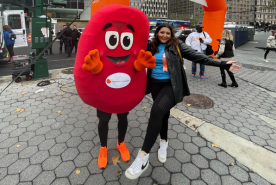Last Updated: May 04, 2023
Medically reviewed by NKF Patient Education Team
About ACE inhibitors & ARBs
ACE (angiotensin converting enzyme) inhibitors and ARBs (angiotensin receptor blockers) are two types of oral (taken by mouth) prescription medicines commonly recommended for people with kidney disease. They represent two different medicine categories but work in similar ways.
These medicines have been used in the United States since the early 1980’s. They are considered “kidney protection” medicines – they can help keep your glomeruli (small filters in your kidneys) healthy and lower your urine albumin-creatinine ratio (uACR) level. They can also lower your risk of cardiovascular disease (CVD, including heart failure, heart attack, or stroke).
Uses
ACE inhibitors and ARBs are used for many different reasons. Some of the most common reasons include:
- High blood pressure (hypertension)
- Chronic kidney disease (CKD)
- Glomerular diseases (such as IgA nephropathy)
- Albuminuria (sometimes referred to as proteinuria)
- Cardiovascular disease (CVD, including heart failure, heart attack, or stroke)
How they work
ACE inhibitors and ARBs both work by lowering the effects of angiotensin-2 (pronounced: an-jee-oh-TEN-sin 2) in the body. Angiotensin-2 is also known as AT2. AT2 is a hormone made by your body that helps balance your blood pressure. When your blood pressure starts to go too low, the body makes AT2 to help bring it up.
The main way AT2 works is by narrowing your blood vessels, especially in the kidneys. When there is too much AT2, the blood vessels in your kidneys are not able to relax. This can cause high blood pressure and/or kidney damage. It can also make heart failure and other types of CVD worse.
Both medicine categories lower the effects of AT2, but in different ways:
- ACE inhibitors slow down how much AT2 your body makes.
- ARBs block the receptors (buttons) that AT2 uses to narrow your blood vessels.
Although ACE inhibitors and ARBs work in separate ways, the result is the same – keep your blood vessels relaxed and lower the pressure on your kidneys (and throughout your body).
Types
There are many different options to choose from. All of them are taken by mouth and most are available as low-cost generic options. Most are taken once a day, although some may need to be taken more often (2-3 times per day).
ACE inhibitors have generic names that end in “-pril”. Common examples include:
- benazepril (Lotensin)
- lisinopril (Zestril, Prinivil)
- quinapril (Accupril)
- ramipril (Altace)
ARBs have generic names that end in “-sartan”. Common examples include:
- irbesartan (Avapro)
- losartan (Cozaar)
- olmesartan (Benicar)
- valsartan (Diovan)
People should not mix medicines from these classes. In other words, use an ACE inhibitor OR an ARB, not both together.
ACE inhibitors have generic names that end in “-pril”. ARBs have generic names that end in “-sartan”.
Effectiveness
All ACE inhibitors and ARBs provide “kidney protection” and other benefits, including:
- lower blood pressure
- lower uACR levels for people with albuminuria
- slow the damage to the glomeruli (small filters in the kidneys) that happens in kidney disease
- slow the damage to the heart muscles that happens in heart failure
- lower risk of heart attack or stroke (especially in people who have already had one before)
One myth about these medicines is they only benefit people who have high blood pressure. This is not true. People with kidney disease or heart failure can still benefit from an ACE inhibitor or ARB even if they do not have high blood pressure. If you do not have high blood pressure, a lower dose may be recommended for you to prevent low blood pressure symptoms.
All ACE inhibitors and ARBs are considered equally effective. This means they all work about the same as each other.
One myth about these medicines is they only benefit people who have high blood pressure. This is not true. People with kidney disease or heart failure can still benefit from an ACE inhibitor or ARB even if they do not have high blood pressure.
Additional considerations
Acute kidney injury (AKI)
ACE inhibitors and ARBs are not likely to cause acute kidney injury (AKI). However, when combined with other factors, your risk of developing AKI goes up. The most common factors that can lead to AKI (when mixed with an ACE inhibitor or ARB) include:
- Taking a non-steroidal anti-inflammatory drug (NSAID), such as:
- ibuprofen (Motrin, Advil)
- naproxen (Aleve)
- diclofenac tablets or capsules (Cataflam, Zipsor)
- celecoxib (Celebrex)
- meloxicam (Mobic)
- aspirin (only if more than 325 mg per day)
- Taking a loop diuretic (water pill) such as:
- furosemide (Lasix)
- torsemide (Demadex)
- bumetanide (Bumex)
- Dehydration (not drinking enough water to meet your body’s needs)
Sometimes combining ACE inhibitors/ARBs with NSAIDs and/or diuretics cannot be avoided. Many people may need these medicines to manage their other health conditions. It is important to talk with your doctor about your risk factors for AKI and how you can lower your risk.
Pregnancy
ACE inhibitors and ARBs should not be used during pregnancy, especially during the second and third trimesters. They can increase the risk of harm to the baby, including fetal death.
Do not change your medicine dose or stop taking your medicine unless you talk with your health care team first.
Questions for your healthcare team
- When should I get blood tests done after I start this medication to check my potassium and eGFR?
- When was the last time my potassium level was checked?
- What can I do to lower my risk for acute kidney injury (AKI)?
- Do any of my other medications increase my risk for acute kidney injury or high potassium?
- What should I do if I am taking an ACE inhibitor or ARB and want to try to get pregnant soon?
This content is provided for informational use only and is not intended as medical advice or as a substitute for the medical advice of a healthcare professional.








